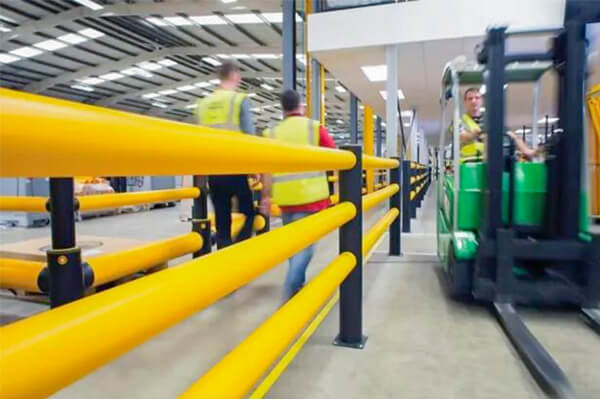Mon - Sat : 9am to 7pm Sunday is CLOSED

Industrial environments are bustling hubs of activity, where efficiency and safety must go hand in hand. One crucial area often overlooked in safety protocols is the loading dock—a vital gateway for goods and materials. Without proper precautions, these high-traffic zones can become hot-spots for accidents and equipment damage. That’s where loading dock safety barriers come into play, serving as a critical line of defense against workplace hazards. This article dives into why these barriers are indispensable, exploring their role in protecting workers, safeguarding equipment, and ensuring smooth operations. Whether you oversee a warehouse, factory, or shipping facility, understanding the importance of loading dock safety barriers could make all the difference in transforming your operational safety standards.

Contents
- 1 Types of Dock Safety Barriers
- 2 Why Dock Safety Barriers Are Essential for Dock Area?
- 3 How to Maximize the Effectiveness of Loading Dock Barriers?
- 4 Conclusion
- 5 FAQs
- 5.1 What are dock safety barriers and their importance in industrial settings?
- 5.2 How do loading dock safety barriers improve workplace security?
- 5.3 What types of dock safety barriers are available?
- 5.4 How can dock safety barriers help prevent falls from loading docks?
- 5.5 What role do gates play in dock safety systems?
- 5.6 How can businesses increase productivity with loading dock safety barriers?
- 5.7 What are the OSHA requirements for dock safety barriers?
- 5.8 How do rail systems integrate with dock safety barriers?
- 5.9 What are the advantages of using nets in dock safety systems?
Types of Dock Safety Barriers
Classification by Structural Form
| Products | Core Features & Application Scenarios |
| Fixed Safety Barriers | Constructed with fixed steel/aluminum alloy frames; non-movable with high protection strength. Suitable for fixed operation areas in docks (e.g., truck parking bays, cargo stacking edges) to withstand vehicle impacts long-term. |
| Foldable Safety Barriers | Foldable for storage; no space occupation when idle. Ideal for narrow passages and temporary operation areas (e.g., temporary unloading points) to ensure smooth movement of vehicles and personnel. |
| Telescopic Safety Barriers | Length-adjustable via hydraulic/manual operation; flexible protection range. Used in variable operation areas of docks (e.g., adapting to parking of trucks of different sizes, setting temporary isolation zones). |
| Mobile Safety Barriers | Equipped with rollers for quick movement; no fixed installation required. Suitable for temporary protection needs (e.g., isolation of equipment maintenance areas, protection of emergency cargo stacking areas). |
Classification by Material & Strength
| Products | Core Features & Application Scenarios |
| Heavy-Duty Steel Barriers | Made of thick steel (≥5mm) with excellent impact resistance. Applicable to main loading/unloading areas of docks where large container trucks operate, to withstand high-impact forces. |
| Aluminum Safety Barriers | Lightweight yet sturdy; balances protection and flexibility. Suitable for areas with light-duty trucks or light cargo handling (e.g., small-package unloading zones), and easy to maintain. |
| High-Strength Plastic Barriers | Made of engineering-grade PP/PE materials; wear-resistant and anti-aging with no sharp edges. Ideal for light cargo handling areas and personnel passage isolation to prevent 磕碰 injuries (bruises/scratches) to staff. |
| Composite Material Barriers | Combined with steel framework + plastic/rubber outer layer; integrates strength and buffering performance. Suitable for scenarios requiring both protection and cargo safety (e.g., loading/unloading zones for electronics or fragile goods). |

Why Dock Safety Barriers Are Essential for Dock Area?
Dock safety barriers play a crucial role in maintaining safety and efficiency in loading dock operations. They are designed to prevent accidents, reduce workplace injuries, and protect valuable equipment. Below are five key reasons why dock safety barriers are essential:
Prevention of Falls
Falling from a loading dock is one of the leading causes of workplace injuries in industrial settings. Safety barriers act as a physical barrier, preventing forklifts, pallet jacks, and employees from accidentally falling off the dock edge.
Protection of Equipment
With heavy machinery and equipment operating near the dock, accidental impacts can cause significant damage. Safety barriers provide a buffer zone to protect equipment, minimizing costly repairs or replacements.
Improved Employee Safety
In busy loading dock areas, where people and vehicles move frequently, even a moment of carelessness can lead to danger. Loading Dock Safety Barriers act as a solid line of defense, creating a protective buffer zone between workers and high-risk areas.
When a vehicle loses control or goods accidentally slide off, these barriers effectively stop the spread of danger, preventing workers from being struck or injured by falling cargo. For example, if a forklift turns too quickly and deviates from its path toward pedestrians, the safety barrier can intercept it in time—significantly reducing the risk of injury.
Enhanced Vehicle Control
Dock safety barriers help manage the movement of trucks and vehicles around the loading dock. By effectively guiding vehicles, they reduce the likelihood of collisions and misalignment during loading and unloading.
Compliance with Safety Regulations
Safety regulations often mandate the implementation of protective measures in industrial settings. Dock safety barriers ensure compliance with these rules, helping businesses avoid legal liabilities and maintaining a safe operational standard.
By understanding and implementing dock safety barriers, businesses can not only enhance workplace safety but also improve operational efficiency and regulatory compliance.
How to Maximize the Effectiveness of Loading Dock Barriers?
Selection Based on Vehicle and Cargo Type
- Heavy-Duty Container Truck Areas:
Use high-strength, impact-resistant barriers—such as heavy-duty steel dock barriers—to withstand strong collision forces generated by large trucks. - Light Truck or Small Cargo Handling Areas:
Choose lightweight yet durable aluminum alloy barriers to balance protection with flexibility and space efficiency.
Adaptation to Site Conditions
- Narrow Aisles or Confined Spaces:
Install foldable or retractable dock barriers that minimize space usage while maintaining smooth traffic flow for both personnel and vehicles. - Open Loading and Unloading Areas:
Opt for fixed dock barriers with greater height and wider coverage to provide comprehensive protection across the entire work zone. - Special Terrain or Ground Surfaces:
Consider dock slope and flooring materials (such as concrete or asphalt) when selecting the barrier type and installation method—whether surface-mounted or embedded—to ensure secure and stable performance.
Professional Installation and Construction
Pre-Installation Site Inspection
A qualified installation team should conduct a detailed on-site inspection to determine the exact installation positions and assess foundation conditions—such as floor load-bearing capacity—while identifying and avoiding potential obstacles within the dock area.
Accurate Foundation Construction
When foundation work is required, measurements and positioning must be carried out with high precision in accordance with design specifications. The foundation’s dimensions, depth, and strength should fully meet safety standards, providing a reliable structural base for the dock barriers.
Secure Installation and Quality Verification
During installation, appropriate connectors and fastening components must be used to ensure all joints are securely fixed, preventing loosening or detachment over time.
After installation, a comprehensive quality inspection should be conducted to verify the flatness, vertical alignment, and connection strength of the barriers—ensuring that the final installation meets all required performance and safety standards.
Regular Maintenance and Inspection: Extending Service Life
Regular maintenance is essential to ensure that Loading Dock Barriers continue to perform effectively over time. A clear and systematic maintenance plan helps maintain safety performance and prolong the product’s lifespan.
Establish a Maintenance Plan
Define detailed inspection schedules, procedures, and evaluation standards, and assign clear responsibilities to ensure consistent implementation.
Routine Inspection and Timely Repair
- Visual Inspection:
Check for any signs of damage, deformation, or loosened joints. Examine the surface for scratches or paint peeling—apply timely repainting or coating to prevent corrosion. - Problem Resolution:
Minor damage can be repaired on-site, such as replacing damaged parts or re-tightening fasteners. For severe issues—such as structural deformation or fracture—the affected barrier should be replaced immediately to prevent loss of protection and ensure ongoing safety compliance.
Conclusion
Loading Dock Barriers, with their strong safety performance, reliable protection for goods and equipment, high adaptability, and long-term cost efficiency, have become an indispensable component of dock safety systems. They serve not only as an effective safeguard against the complex risks of dock operations but also as a fundamental requirement for corporate safety compliance.
SEPPES has partnered with more than 5,600 enterprises and factories, and its numerous successful installations have proven the value of its Loading Dock Barriers in ensuring safe, efficient, and compliant dock operations worldwide.
FAQs
What are dock safety barriers and their importance in industrial settings?
Dock safety barriers are physical structures designed to protect personnel and equipment in loading dock areas. They prevent falls from loading docks and provide a clear demarcation between pedestrian walkways and vehicle traffic, enhancing overall safety and productivity in industrial environments.
How do loading dock safety barriers improve workplace security?
Loading dock safety barriers improve workplace security by establishing boundaries that prevent unauthorized access to dangerous areas. They act as a protective barrier, reducing the risk of accidents involving forklifts and other vehicles, thus ensuring a safer working environment.
What types of dock safety barriers are available?
There are various types of dock safety barriers available, including fixed barriers, collapsible barriers, and mobile barriers. Each type serves a specific purpose, whether it’s to create a permanent safety zone or to provide a flexible solution that can be easily moved as needed.
How can dock safety barriers help prevent falls from loading docks?
Dock safety barriers help prevent falls from loading docks by acting as a physical barrier that keeps workers and equipment safely within designated areas. Their design often includes features like guardrails and nets that catch falling objects or individuals, significantly reducing the risk of injury.
What role do gates play in dock safety systems?
Gates are essential components of dock safety systems, allowing controlled access to loading areas while preventing unauthorized entry. They can be equipped with locking mechanisms and safety features to ensure that only trained personnel can access high-risk areas, thus enhancing overall safety.
How can businesses increase productivity with loading dock safety barriers?
Businesses can increase productivity with loading dock safety barriers by minimizing accidents and injuries, which can lead to costly downtime. A safer working environment allows employees to focus on their tasks without the distraction of potential hazards, leading to more efficient operations.
What are the OSHA requirements for dock safety barriers?
OSHA requires that employers provide a safe working environment, which includes the implementation of appropriate dock safety barriers. These barriers must meet specific standards to ensure they effectively protect workers from falls and other potential hazards associated with loading docks.
How do rail systems integrate with dock safety barriers?
Rail systems can integrate with dock safety barriers by using barriers that accommodate rail operations while still providing safety for workers. This integration ensures that there is a clear separation between rail activities and pedestrian areas, reducing the risk of accidents.
What are the advantages of using nets in dock safety systems?
Nets in dock safety systems provide an additional layer of protection by catching falling objects and preventing them from hitting workers below. They are particularly useful in high-traffic areas where materials are frequently loaded and unloaded, contributing to a safer work environment.
